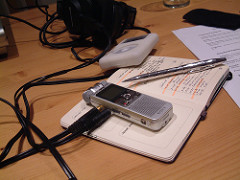In this post, Jacqueline Priego introduces the new blog feature ‘Tales from the field’.
One of the main thrusts of CEL is driving pedagogic research, leading up to the next REF submission in Unit of Assessment 25. As part of this effort, I started working here as a research fellow a year ago. In this role and through my teaching and consultancy work, I have realised that although there is much written on research methods, sometimes it is the practicalities that are missing when guiding junior and non-research colleagues. As a small contribution to address this gap, and in the hope to trigger discussion and practical tips within the BU community, I will be blogging fortnightly about diverse ‘Tales from the field’, focusing on qualitative and mixed-methods data collection.
The first topic I would like to write about is digital recording. Some of us who at some point recorded with old dictaphones might be surprised at the easiness with which some colleagues suggest “just use your mobile phone”. Some others might worry about the quality of the recording and avoid non-specialised devices to achieve a clear, sharp recording. Is it the case that we need a specific (technological) tool for the (audiorecording) task?

Image credit: Bernard Goldbach (CC BY 2.0).
Using personal devices (i.e. devices being used for personal benefit, not exclusively for research) for data collection hardly ever guarantees proper handling of confidential data –‘wiping’ a mobile phone, for example, can be a complex process even for the technology-minded. Add to this the possibility of poor battery performance and chances of relatives ringing during the interview, and mobile phones become an inconvenient option. Furthermore, while non-specialised devices might just do the job, high-fidelity recordings open up possibilities for sound analysis and aid the transcription process – that is why some transcribing agencies charge more for noisy backgrounds and foreign accents.
I have been using my old trusty digital recorder for nine years, and highly recommend it. It has travelled everywhere with me, from the Mexican highlands to Delhi slums. More recently, I have also used more specialised equipment, including this kit. There is an enormous variety of specs, but it is worth reading the different options in terms of sound capture and microphone sensitivity, as well as data storage.
Depending on the purposes of the recording, it is important to check the inputs and outputs of the device. In terms of outputs, a USB port is almost essential to transfer files swiftly and securely. As for inputs, it is convenient that the recorder has the option of connecting other appliances such as headphones. For focus group discussions, an omni-directional (conference) microphone can be plugged into the recording device with the relevant input, helping to capture multi-party conversations.
And you, what practical tips would you share about audiorecorders for fieldwork?
Explore the links in this post for more information. Further recommended reading:
Paulus, T., Lester, J., & Dempster, P. (2013). Digital tools for qualitative research. London: Sage.

Jacqueline Priego is a research fellow at BU’s Centre for Excellence in Learning, having previously curated the research blog Favelas@LSE. She has worked in social research for over nine years, specialising in qualitative and mixed-methods. Jacqueline is a CAQDAS trainer and consultant with particular interest in participatory and creative methods. She tweets @jacqpriego







